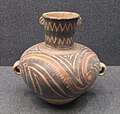Banshan Machang culture
The Banshan Machang Culture ( Chinese 半山 - 马 厂 文化 , Pinyin Bànshān-Mǎchǎng wénhuà , English Banshan-Machang Culture ) was a late Neolithic culture in the area of the upper Huang He (Yellow River) in Gansu and Qinghai in northwest China . According to the radiocarbon method , the Banshan-Machang culture is dated from around 2500 to 2000 BC. Dated.
The various eponymous sites were initially discovered separately in 1923 in Banshan (半山), Hezheng (和政) ( Gansu Province ) and Machangyuan (马 厂 塬), Minhe (民和) ( Qinghai Province ). The sites were initially assigned to the Majiayao culture (which is also known as the Yangshao culture from Gansu (Gānsù Yǎngsháo Wénhuà)), but their ceramics with colored decoration show relatively many differences to that of Majiayao.
The culture was mainly spread in the catchment area of the Tao He (洮河) and Daxia He (大 夏河) rivers in Gansu and the Huang Shui (湟 水) in Qinghai Province . Agriculture was the most important economic factor, stone knives, stone axes and bone arrowheads were used. As for domestic animals, there were pigs and dogs.
The handcrafted clay pots come in the shapes hú (壶), wèng (瓮), guàn (罐) and pén (盆). The ceramics with colored decoration is very developed. The colors red and black are used to decorate the ceramics from Banshan , and they are often framed with sawtooth-shaped patterns. The ceramics with colored decoration from Machang often use red color, the shape and ornamentation are very close to that of Banshan, they resemble an earlier and later stage of development of the same culture.
The Machangyuan site (Machangyuan yizhi 马 厂 塬 遗址) in Minhe 's Hui and Tu Autonomous County has been on the List of Monuments of the People's Republic of China (3-191) since 1988 .
gallery
Human head, part of an urn from the Banshan phase of the Yangshao culture. East Asian Museum ( Östasiatiska Museet ), Stockholm.
Painted pottery jug from the Banshan phase of the Yangshao culture. Museum of the Mausoleum of the King of Nanyue from the Western Han Dynasty , Guangzhou, China.
See also
literature
- Cihai ("Sea of Words"), Shanghai cishu chubanshe, Shanghai 2002, ISBN 7-5326-0839-5
- Zhongguo da baike quanshu : Kaoguxue (archeology). Beijing: Zhongguo da baike quanshu chubanshe, 1986
- Gansu Sheng Bowuguan 甘肃 省 博物馆 等 [Gansu Provincial Museum]: "Lanzhou Tugutai Banshan-Machang wenhua mudi 兰州 土 谷 台 半山 - 马 厂 文化 墓地", Kaogu xuebao考古学 报, 1983.2
Web links
- org / library / 2008-02 / 15 / content_33544.htm Machangyuan Site - English
- Banshan Machang wenhua wawen caitao
- Archaeological discoveries at the Lajia site, Minhe County, Qinghai Province (sites discovered by JG Anderson)
Individual evidence
- ↑ Cihai , p. 66.
- ↑ Cihai , p. 66. This work deals with this culture under the name used here. The following illustration is closely aligned with the Cihai .
- ↑ See the entries Banshan yizhi (Banshan site) and Machang yizhi (Machang site) in the archeology volume of the Great Chinese Encyclopedia ( Zhongguo da baike quanshu ).
- ↑ Cihai , p. 66.
- ↑ K-11038-005 :: Lock , on kulturarvsdata.se


